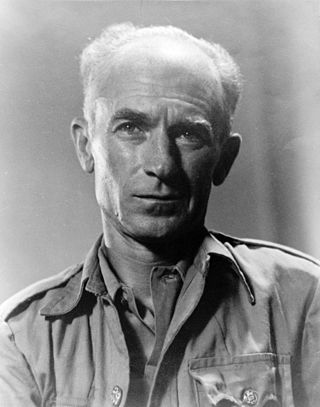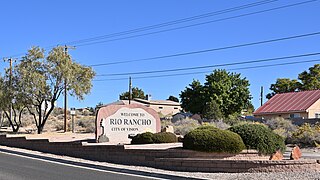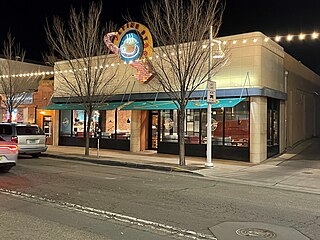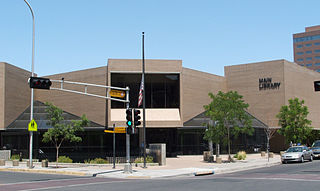
Albuquerque, also known as ABQ, Burque, and the Duke City, is the most populous city in the U.S. state of New Mexico. Founded in 1706 as La Villa de Alburquerque by Santa Fe de Nuevo México governor Francisco Cuervo y Valdés, and named in honor of Francisco Fernández de la Cueva, 10th Duke of Alburquerque and Viceroy of New Spain, it served as an outpost on El Camino Real linking Mexico City to the northernmost territories of New Spain.

Los Ranchos de Albuquerque, known locally simply as "Los Ranchos" or "The Village," is a village in Bernalillo County, New Mexico. The population was 6,024 at the time of the 2010 Census.

Ernest Taylor Pyle was a Pulitzer Prize–winning American journalist and war correspondent who is best known for his stories about ordinary American soldiers during World War II. Pyle is also notable for the columns he wrote as a roving human-interest reporter from 1935 through 1941 for the Scripps-Howard newspaper syndicate that earned him wide acclaim for his simple accounts of ordinary people across North America. When the United States entered World War II, he lent the same distinctive, folksy style of his human-interest stories to his wartime reports from the European theater (1942–44) and Pacific theater (1945). Pyle won the Pulitzer Prize in 1944 for his newspaper accounts of "dogface" infantry soldiers from a first-person perspective. He was killed by enemy fire on Iejima during the Battle of Okinawa.
Ward Hill is a hill and eponymous neighborhood located in the northeastern part of Staten Island, New York City. Ward Hill is the northernmost of a chain of hills that stretch approximately halfway across Staten Island, which at one point rises to 410 feet, the highest elevation found that close to the seabord south of Maine in the eastern United States.

Old Town is the historic original town site of Albuquerque, New Mexico, for the provincial kingdom of Santa Fe de Nuevo México, established in 1706 by New Mexico governor Francisco Cuervo y Valdés. It is listed on the New Mexico State Register of Cultural Properties as the Old Albuquerque Historic District, and is protected by a special historic zoning designation by the city. However, prior to its establishment as a city in the Santa Fe de Nuevo México province, many indigenous tribes lived there including Diné, Pueblo, Apache, Tiwa, and others. The present-day district contains about ten blocks of historic adobe buildings surrounding Old Town Plaza. On the plaza's north side stands San Felipe de Neri Church, a Spanish colonial church constructed in 1793.

Rio Rancho is the largest and most populous city in Sandoval County, part of the expansive Albuquerque metropolitan area, in the U.S. state of New Mexico. A small portion of the city extends into northern Bernalillo County.

Downtown Albuquerque is the central business district of Albuquerque, New Mexico, United States. It is where a significant number of the city's highrise buildings are located, and is the center of government and business for the Greater Albuquerque metropolitan region.

The Mark Twain Boyhood Home & Museum is located on 206-208 Hill Street, Hannibal, Missouri, on the west bank of the Mississippi River in the United States. It was the home of Samuel Langhorne Clemens, better known as author Mark Twain, from 1844 to 1853. Clemens found the inspiration for many of his stories, including the white picket fence, while living here. It has been open to the public as a museum since 1912, and was designated a National Historic Landmark on December 29, 1962. It is located in the Mark Twain Historic District.

Flying Star Cafe is a privately owned and operated cafe restaurant chain in Albuquerque, New Mexico, USA.

The Albuquerque Bernalillo County Library is the public library system serving greater Albuquerque, New Mexico, United States. It includes seventeen branch libraries as well as the downtown Main Library.

The Flushing Friends Quaker Meeting House, also the Old Quaker Meeting House, is a historic Quaker house of worship located at 137-16 Northern Boulevard, in Flushing, Queens, New York. It was declared a National Historic Landmark in 1967 and a New York City designated landmark in 1970. Today, it still serves as a Quaker Meeting, with meetings for worship taking place every Sunday.

Monmouth is a historic antebellum home located at 1358 John A. Quitman Boulevard in Natchez, Mississippi on a 26-acre (11 ha) lot. It was built in 1818 by John Hankinson, and renovated about 1853 by John A. Quitman, a former Governor of Mississippi and well-known figure in the Mexican–American War. It is one of Natchez's grandest Greek Revival mansions. It was declared a Mississippi Landmark in 1986 and a National Historic Landmark in 1988. It is now a small luxury hotel.

This is a list of the National Register of Historic Places listings in Bernalillo County, New Mexico.

Nob Hill is a neighborhood in Albuquerque, New Mexico, United States, consisting of a commercial district along Central Avenue and surrounding residential areas. Located just east of the University of New Mexico, the neighborhood was developed between about 1925 and 1950 and has since become a popular tourist and shopping destination. Known for its eclectic mix of mostly locally owned businesses, Nob Hill has been described as "the heart of Albuquerque's Route 66 culture and also its hippest, funkiest retail and entertainment district". The neighborhood is named after Nob Hill in San Francisco, California.
The following is a timeline of the history of the city of Albuquerque, New Mexico, US.

The Old Main Library is a historic building in the Huning Highlands neighborhood of Albuquerque, New Mexico, originally built in 1925 as the main facility of the Albuquerque Public Library. Since the opening of the current Main Library in 1975, it has served as the library system's Special Collections branch, housing historical and genealogical research materials. Designed by Arthur Rossiter with interior decorations by Gustave Baumann, the building is a notable example of Pueblo Revival architecture. It was added to the New Mexico State Register of Cultural Properties in 1975 and is also an Albuquerque Historic Landmark.

Martineztown-Santa Barbara is a neighborhood in central Albuquerque, New Mexico, immediately northeast of Downtown. Originating as a small farming village in the 1850s, it is one of the city's oldest neighborhoods and retains a distinct character, with winding streets, irregular lots, and adobe vernacular buildings reminiscent of other old Hispanic communities in northern New Mexico.

Huning Highlands, also known as EDo or East Downtown, is an inner-city neighborhood in Albuquerque, New Mexico, directly east of Downtown. It is a mostly residential area known for its high concentration of Victorian and early 20th-century houses and is listed on the National Register of Historic Places as the Huning Highlands Historic District. There is also a commercial district along the main thoroughfares, Central Avenue and Broadway Boulevard. Huning Highlands was developed starting in 1880 and is named for Franz Huning, a prominent businessman at the time.

The Main Library is a public library in Downtown Albuquerque, New Mexico and the main branch of the Albuquerque Bernalillo County Library system. Opened in 1975, it was designed by local architect George Pearl and listed on the National Register of Historic Places in 2019. The library is a concrete-framed Brutalist structure designed to maximize the flexibility of the interior space with a modular layout and movable partitions. Pearl considered it one of his "three or four most important" designs. In 2020, the building was designated an Albuquerque historic landmark.

















